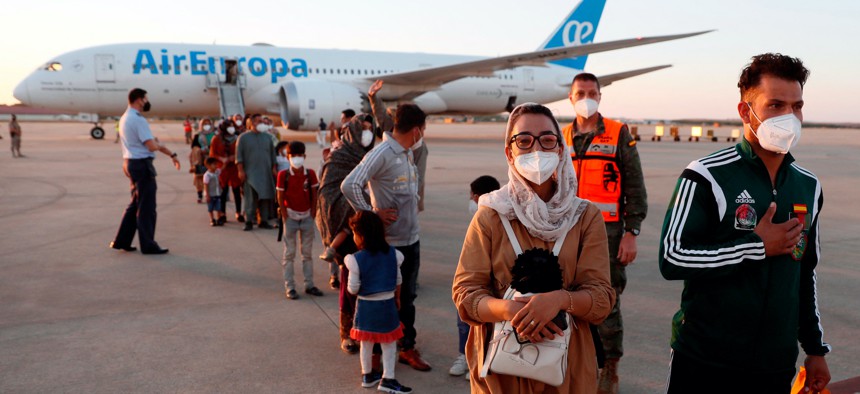
The captain of Afghanistan's women's wheelchair basketball team Nilofar Bayat (2R) and her husband Ramish (R) disembark from a second Spanish evacuation airplane, carrying Afghan collaborators and their families, that landed at the Torrejon de Ardoz air base, 30 km away from Madrid, on August 20, 2021. MARISCAL/POOL/AFP via Getty Images
Defense Secretary Orders US Airlines to Help With Evacuation
It's only the third time in history that the U.S. airlines have been mobilized by the military.
Updated: Aug. 22, 8:26 a.m. ET
Defense Secretary Lloyd Austin has ordered the Civil Reserve Air Fleet to activate, requesting 18 aircraft from the U.S. airlines to help in the evacuation of Afghans and Americans.
It marks the third time in history that the military has mobilized the U.S. airlines to help with a military evacuation. Some 22,000 Americans and Afghans have been flown out of Afghanistan since July; 17,000 in the past week alone.
Austin’s order calls for American Airlines, Atlas Air, and Delta Air Lines to provide three aircraft, the Pentagon said in an emailed statement on Sunday morning. Omni Air and Hawaiian Airlines must each provide two aircraft. United Airlines will provide four planes.
The civilian airliners will not go into Kabul. Military aircraft will continue to airlift passengers out of Afghanistan’s capital to staging bases in the Middle East. The commercial airlines will take the second leg, flying them to the U.S. or other temporary housing locations, such as Ramstein Air Base in Germany.
The Civil Reserve Air Fleet is "a cooperative, voluntary program involving the [Transportation Department], DoD and the U.S. civil air carrier industry in a partnership to augment DoD aircraft capability during a national defense related crisis," as the Transportation department's website puts it. "Air carriers volunteer their aircraft to the CRAF program through contractual agreements with U.S. Transportation Command (USTRANSCOM), located at Scott Air Force Base, Illinois. In return, the participating carriers are given preference in carrying commercial peacetime cargo and passenger traffic for DoD."
On Friday night, U.S. Transportation Command told U.S. airlines that it might activate the CRAF.
“A warning order informs industry partners of a potential activation but can be rescinded if the Defense Department deems additional aircraft are not required to meet mission requirements. Working with military and industry leaders, U.S. Transportation Command is supporting efforts to transport U.S. citizens, Special Immigrant Visa applicants, and other at-risk individuals from Afghanistan,” said Transportation Command spokesman Navy Capt. John Perkins.
Earlier on Friday, Brig. Gen. Dan DeVoe, the commander overseeing U.S. Air Force aerial refueling tankers, acknowledged in a call with reporters that flying planes directly to the United States would require multiple refuelings and reduce the number of aircraft going in and out of Afghanistan.
“I’m taking [the C-17s] out of the proverbial fight, if you will, for a longer period of time before I get them back in,” DeVoe said. “[That], in the longer run, reduces the number of evacuees that I can get out of Afghanistan.”
The C-17s had been flying to Al Udeid Air Base, a large base outside of Doha, Qatar, used by the U.S. military, but the processing facility there reached capacity Friday.
Germany said the U.S. could ferry evacuees through Ramstein Air Base—another facility already used by the U.S. military—as a stop on the way back to the United States. The Air Force posted pictures on its Facebook page showing Ramstein being readied for Afghan refugees. The Pentagon said Friday that it was preparing to house 22,000 Afghans at three U.S. Army bases in the United States.
The Civil Reserve Air Fleet is made up of commercial aircraft that the airlines, cargo, and charter carriers make available to the military during an emergency. The consortium was created in the 1950s to assist the military in an emergency by flying people and supplies. The Pentagon has only activated the Civil Reserve Air Fleet twice: in the leadups to the 1990 and 2003 Iraq wars.
All of the major U.S. airlines—including United, American, and Delta—are part of the Civil Reserve Air Fleet.
“The DoD’s ability to project military forces is inextricably linked to commercial industry, which provides critical transportation capacity as well as global networks to meet day-to-day and contingency requirements,” the Pentagon said Sunday. “Utilizing commercial partners expands USTRANSCOM’s global reach as well as access to valuable commercial intermodal transportation systems. The DoD’s ability to project military forces is inextricably linked to commercial industry, which provides critical transportation capacity as well as global networks to meet day-to-day and contingency requirements.”
In addition to Civil Reserve Air Fleet mobilization, the U.S. government has other options for getting the evacuees back to the United States on commercial airliners, according to current and former military and defense officials.
One is through what officials call commercial augmentation, where the Pentagon hires an airline, or airlines to fly their own planes. Another is for the State Department to contract directly with commercial airlines. Unlike the Civil Reserve Air Fleet, which exclusively uses U.S. air carriers, the State Department can contract with U.S. or foreign airlines. The State Department did this when it airlifted 15,000 American citizens out of Lebanon during the 2006 war.
Some large airlines have grounded their largest, widebody aircraft, the type most useful for this mission, due to international travel restrictions put in place fordue to the COVID-19 pandemic. Emirates, the Dubai-based airline, has grounded dozens of its Airbus A380 super jumbo airliners during the pandemic. Etihad, the Abu Dhabi-based carrier, has grounded all 10 of its A380s, as has Qatar Airways. It’s unclear how quickly they could return to service if the U.S. contracted either carrier.




